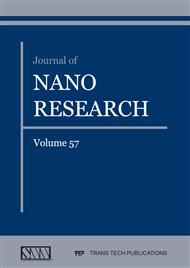[1]
H.-J. Zhai, J. Li, L.-S. Wang, H. M., Icosahedral gold cage clusters: M@Au12− (M=V, Nb, and Ta), J. Chem. Phys., 121 (2004) 8369-8374.
DOI: 10.1063/1.1799574
Google Scholar
[2]
M. Haruta, N. Yamada, T. Kobayashi, S. Iijima, Gold catalysts prepared by coprecipitation for low-temperature oxidation of hydrogen and of carbon monoxide, J. Catal., 115 (1989) 301-309.
DOI: 10.1002/chin.198920020
Google Scholar
[3]
M. Haruta, Gold as a low-temperature oxidation catalyst: Factors controlling activity and selectivity, Stud. Surf. Sci. Catal., 110 (1997) 123-134.
Google Scholar
[4]
M. Valden, X. Lai, D.W. Goodman, Onset of catalytic activity of gold clusters on titania with the appearance of nonmetallic properties, Science, 281 (1998) 1647-1650.
DOI: 10.1126/science.281.5383.1647
Google Scholar
[5]
T. Mallat, A. Baiker, Oxidation of alcohols with molecular oxygen on solid catalysts, Chem. Rev., 104 (2004) 3037-3058.
DOI: 10.1021/cr0200116
Google Scholar
[6]
G.R. Bamwenda, S. Tsubota, T. Nakamura, M. Haruta, The influence of the preparation methods on the catalytic activity of platinum and gold supported on TiO2 for CO oxidation, Catal. Lett., 44 (1997) 83-87.
Google Scholar
[7]
Y. Mikami, A. Dhakshinamoorthy, M. Alvaro, H. Garcia, Catalytic activity of unsupported gold nanoparticles, Catal. Sci. Technol., 3 (2013) 58-69.
DOI: 10.1039/c2cy20068f
Google Scholar
[8]
J.A. Van Bokhoven, Catalysis by gold: Why size matters, Chimia, 63 (2009) 257-260.
DOI: 10.2533/chimia.2009.257
Google Scholar
[9]
D. Horváth, L. Toth, L. Guczi, Gold nanoparticles: Effect of treatment on structure and catalytic activity of Au/Fe2O3 catalyst prepared by co‐precipitation, Catal. Lett., 67 (2000) 117-128.
Google Scholar
[10]
J. Hu, L. Chen, K. Zhu, A. Suchopar, R. Richards, Aerobic oxidation of alcohols catalyzed by gold nano-particles confined in the walls of mesoporous silica, Catal. Today, 122 (2007) 277-283.
DOI: 10.1016/j.cattod.2007.01.012
Google Scholar
[11]
A. Abad, A. Corma, H. García, Catalyst parameters determining activity and selectivity of supported gold nanoparticles for the aerobic oxidation of alcohols: The molecular reaction mechanism, Chem.- Eur. J., 14 (2008) 212-222.
DOI: 10.1002/chem.200701263
Google Scholar
[12]
M. Besson, P. Gallezot, Deactivation of metal catalysts in liquid phase organic reactions, Catal. Today, 81 (2003) 547-559.
DOI: 10.1016/s0920-5861(03)00153-6
Google Scholar
[13]
B.G. Donoeva, D.S. Ovoshchnikov, V.B. Golovko, Establishing a Au nanoparticle size effect in the oxidation of cyclohexene using gradually changing Au catalysts, ACS Catal., 3 (2013) 2986-2991.
DOI: 10.1021/cs400701j
Google Scholar
[14]
B.J. Auten, H. Lang, B.D. Chandler, Dendrimer templates for heterogeneous catalysts: Bimetallic Pt–Au nanoparticles on oxide supports, Appl. Catal., B, 81 (2008) 225-235.
DOI: 10.1016/j.apcatb.2007.12.012
Google Scholar
[15]
D. Astruc, F. Lu, J.R. Aranzaes, Nanoparticles as recyclable catalysts: The frontier between homogeneous and heterogeneous catalysis, Angew. Chem., Int. Ed., 44 (2005) 7852-7872.
DOI: 10.1002/anie.200500766
Google Scholar
[16]
L.-C. Wang, L. He, Y.-M. Liu, Y. Cao, H.-Y. He, K.-N. Fan, J.-H. Zhuang, Effect of pretreatment atmosphere on CO oxidation over α-Mn2O3 supported gold catalysts, J. Catal., 264 (2009) 145-153.
DOI: 10.1016/j.jcat.2009.04.006
Google Scholar
[17]
V.R. Choudhary, D.K. Dumbre, Solvent-free selective oxidation of benzyl alcohol to benzaldehyde by tert-butyl hydroperoxide over U3O8-supported nano-gold catalysts, Appl. Catal., A, 375 (2010) 252-257.
DOI: 10.1016/j.apcata.2010.01.007
Google Scholar
[18]
R. Narayanan, M.A. El-Sayed, Catalysis with transition metal nanoparticles in colloidal solution: Nanoparticle shape dependence and stability, J. Phys. Chem. B, 109 (2005) 12663-12676.
DOI: 10.1021/jp051066p
Google Scholar
[19]
C. Qi, M. Okumura, T. Akita, M. Haruta, Vapor-phase epoxidation of propylene using H2/O2 mixture over gold catalysts supported on non-porous and mesoporous titania-silica: Effect of preparation conditions and pretreatments prior to reaction, Appl. Catal., A., 263 (2004) 19-26.
DOI: 10.1016/j.apcata.2003.11.034
Google Scholar
[20]
J. Zhu, J.L. Figueiredo, J.L. Faria, Au/activated-carbon catalysts for selective oxidation of alcohols with molecular oxygen under atmospheric pressure: Role of basicity, Catal. Commun., 9 (2008) 2395-2397.
DOI: 10.1016/j.catcom.2008.05.041
Google Scholar
[21]
A. Abd El-Moemen, A. Karpenko, Y. Denkwitz, R.J. Behm, Activity, stability and deactivation behavior of Au/CeO2 catalysts in the water gas shift reaction at increased reaction temperature (300 °C), J. Power Sources, 190 (2009) 64-75.
DOI: 10.1016/j.jpowsour.2008.07.084
Google Scholar
[22]
E. Bus, R. Prins, J.A. van Bokhoven, Origin of the cluster-size effect in the hydrogenation of cinnamaldehyde over supported Au catalysts, Catal. Commun., 8 (2007) 1397-1402.
DOI: 10.1016/j.catcom.2006.11.040
Google Scholar
[23]
A. Beck, A. Horváth, Z. Schay, G. Stefler, Z. Koppány, I. Sajó, O. Geszti, L. Guczi, Sol derived gold-palladium bimetallic nanoparticles on TiO2: Structure and catalytic activity in CO oxidation, Top. Catal., 44 (2007) 115-121.
DOI: 10.1007/s11244-007-0284-x
Google Scholar
[24]
J.E. Hutchinson, E.W. Foster, M.G. Warner, S.M. Reed, W.W. Weare, Triphenylphosphine-stabilised gold nanoparticles, in: J.R. Shapley (Ed.) Inorganic syntheses, (Willey & Sons) 2004, pp.228-232.
Google Scholar
[25]
V. Raghuveer, A. Manthiram, Mesoporous carbons with controlled porosity as an electrocatalytic support for methanol oxidation, J. Electrochem. Soc., 152 (2005) A1504-A1510.
DOI: 10.1149/1.1940767
Google Scholar
[26]
J.A. Lopez-Sanchez, N. Dimitratos, C. Hammond, G.L. Brett, L. Kesavan, S. White, P. Miedziak, R. Tiruvalam, R.L. Jenkins, A.F. Carley, D. Knight, C.J. Kiely, G.J. Hutchings, Facile removal of stabilizer-ligands from supported gold nanoparticles, Nat. Chem., 3 (2011) 551-556.
DOI: 10.1038/nchem.1066
Google Scholar
[27]
ImageJ (Image processing and analysis in Java program inspired by NIH image), 2010, https://imagej.net/Downloads.
Google Scholar
[28]
S. Ghadamgahi, B.E. Williamson, V.B. Golovko, Activity of catalysts derived from Au101 immobilized on activated carbon, Catal. Lett, 146 (2016) 1027-1032.
DOI: 10.1007/s10562-016-1722-9
Google Scholar
[29]
K. Heidkamp, N. Decker, U. Prüße, Catalyst development for the selective oxidation of ethoxylates to their corresponding ether carboxylic acids, Catal. Commun., 40 (2013) 88-92.
DOI: 10.1016/j.catcom.2013.06.015
Google Scholar


